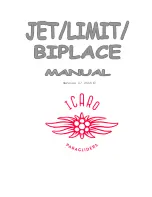
Aircraft Operating Instructions (AOI)
Type:
CT
Series:
CTLS
LSA
Page: 4-6
AU 010 11000
Revision No. 4
Date: 29 Apr 2008
they must be secured so that they cannot shift even if the aircraft
experiences strong vertical gusts and accelerations.
4.3. Passenger
briefing
Before take-off, passengers should be briefed on the emergency procedures. This
ensures that in an emergency passengers will act properly and not become a further
problem for the pilot.
Even although one can confidently assume that these circumstances may never
happen, it is important that they be discussed calmly on the ground. In this way, one
can be sure that if it comes to it, the passenger will react correctly. The briefing
should include at the least the following points.
Passengers should be briefed on the proper use of the safety harness - how it is
worn, locked, tightened and opened. The safety harness is tightened first at the waist
and then the shoulders in order to prevent the lap strap from riding up in a dangerous
manner. The safety harness should be held tight at all times as light aircraft such as
the CTLS can experience turbulence at any time during flight.
The door latching mechanism should be demonstrated. Particular emphasis should
be placed on the fact that the doors must be pulled firmly against the door seals
before locking the doors in order to prevent the latches from jamming.
Deployment of the recovery system should be explained. Passengers must be told of
the importance of the handle in the middle console and how to operate it. In the
unlikely event that the pilot is incapacitated, this information is very important.
Warning:
Even if the passenger is an experienced General Aviation pilot, he/she
should be briefed on the peculiarities of Light Sport aircraft. This is
especially the case with respect to the parachute recovery system as
these are usually not installed in GA aircraft.
A fire extinguisher spray is provided in a pocket on the back of the passenger seat. It
can be used to extinguish small fires in the cockpit. This may be necessary after an
emergency landing. Briefing passengers accordingly on the use of the fire
extinguisher spray is very important.
If immediate help is required after an emergency landing, the ELT (if installed) can be
activated using the remote control in the lower central panel. If the pilot is no longer
capable of acting, the passenger should know how he can activate the unit. This
information is very important.














































